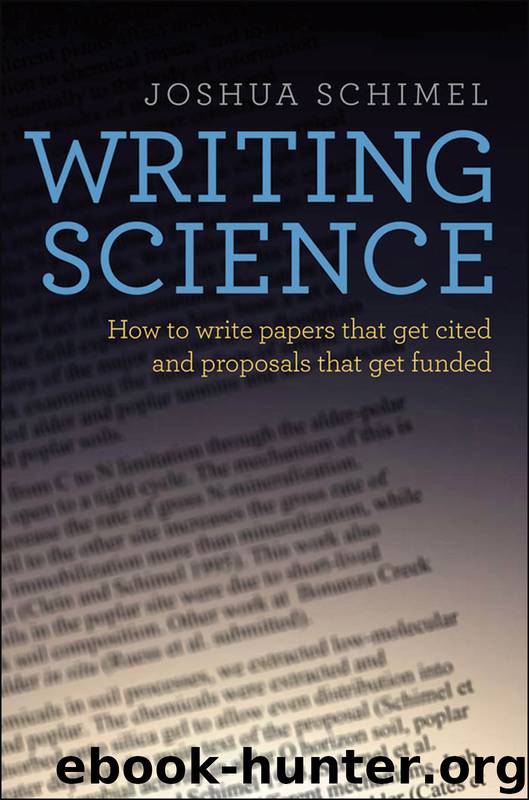Writing Science by Schimel Joshua;

Author:Schimel, Joshua; [Schimel, Joshua;]
Language: eng
Format: epub
ISBN: 9780199760237
Publisher: Oxford University Press
Published: 2012-01-15T07:00:00+00:00
The point of this paragraph is that mammoths did not migrate long distances, which is presented in the closing sentence—hence, point-last. The first sentence poses the question (did they migrate long distances?) and the approach to answering it (Sr isotope ratios). It serves as both opening and challenge, but it doesn’t answer the question and so doesn’t resolve. It acts as a guide to the story but as a classic OCAR opening, rather than as an LDR lead.
Another excellent example of a point-last OCAR paragraph is Example 10.1 about population density and watershed N-export. That paragraph opens by arguing that these might be related. The second sentence poses the challenge, asking whether differences in population density could explain the differences in N-export between north and south. Several more sentences develop the action, leading to the resolution: population density cannot explain the patterns of N-export.
Point-last paragraphs are not terribly common; they might account for 25–30 percent of a paper. Writing is dominated by point-first paragraphs, particularly by TS-D, which is the bread-and-butter paragraph. The complex structures, however, often appear at critical story points—openings, resolutions, and transitions—so you must learn when and how to use them. Additionally, although short paragraphs are usually TS-D, long paragraphs benefit from a resolution to tie them together and remind the reader of the point; they lean toward LDR or OCAR.
I’ve presented these structures as distinct, but they are not; rather, they form a spectrum from paragraphs with all the power in the first sentence to those with it all in the last—pure TS-D to pure OCAR. Some paragraphs may be hard to classify definitively as TS-D, LD, LDR, or OCAR. Slight shifts in the weighting of a sentence, or of a reader’s interpretation, might change how they would define the structure. It’s better when the structure is apparent, because if it is unclear, then the point may be, too. It’s okay to write point-first paragraphs, and it’s okay to write point-last paragraphs, but don’t write point-nowhere paragraphs.
Download
This site does not store any files on its server. We only index and link to content provided by other sites. Please contact the content providers to delete copyright contents if any and email us, we'll remove relevant links or contents immediately.
Barron's AP Biology by Goldberg M.S. Deborah T(3925)
Aliens by Jim Al-Khalili(2681)
MCAT Physics and Math Review 2019-2020 by Kaplan Test Prep(1668)
Cracking the AP Physics C Exam, 2018 Edition by Princeton Review(1610)
The Two Cultures by C. P. Snow(1205)
Biology For Dummies by Fester Kratz Rene(1179)
Biology For Dummies (For Dummies (Math & Science)) by Rene Fester Kratz(1173)
500 AP Chemistry Questions to Know by Test Day(1149)
Cracking the AP Chemistry Exam, 2012 Edition by Princeton Review(1135)
MCAT Organic Chemistry Review 2019-2020 by Kaplan Test Prep(1131)
MCAT General Chemistry Review 2019-2020 by Kaplan Test Prep(1100)
Cracking the AP Physics 2 Exam, 2018 Edition by Princeton Review(1077)
Cracking the AP Chemistry Exam, 2018 Edition by Princeton Review(1045)
McGraw-Hill Education Preparation for the GED Test by McGraw-Hill Education Editors(1036)
Aliens: The World's Leading Scientists on the Search for Extraterrestrial Life by Jim Al-Khalili(1023)
500 AP Chemistry Questions to Know by Test Day by Mina Lebitz(1008)
Chemistry Essentials For Dummies by John T. Moore(996)
McGraw-Hill Education SAT Subject Test Biology by Stephanie Zinn(988)
Cracking the AP Environmental Science Exam, 2018 Edition by Princeton Review(959)
